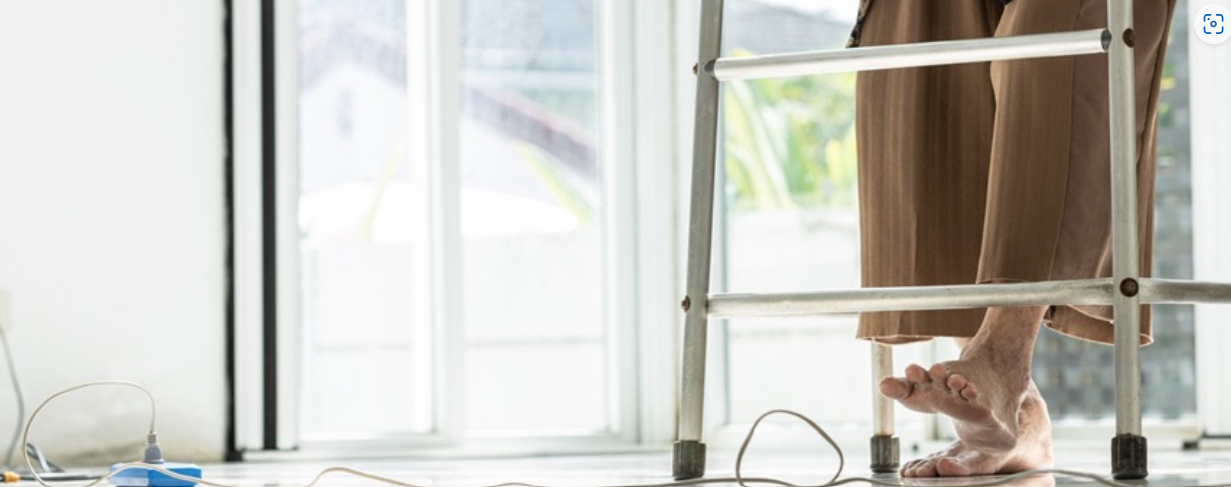[Article] Addressing your environment for falls prevention?

The Bottom Line
- Globally, more than 680 thousand people die from falling every year, while millions more require medical care.
- Environmental hazards, such as poor lighting and walking surfaces, are responsible for 30% to 50% of falls experienced by older adults.
- Environmental programs that remove fall-hazards in the home can lower the number of falls experienced by community-dwelling older adults who are at high risk of falling.
- Consult with your healthcare team about your risk of falls and what environmental strategies may be best for you.
Outside of falling in love or things falling into place, falling is something we want to avoid, especially as we age. The stats speak for themselves: each year, more than 37 million falls result in the need for medical attention and over 680 thousand people die from falling around the globe (1).
In Canada, most older adults — over 92% — live in the community, meaning in a private dwelling or a residence specifically for older adults like a retirement community (2). Outside of their age, older adults living in the community face various risks that increase their chances of experiencing a fall. These include having a previous history of falls, living with one or more chronic diseases, sensory issues, limited mobility, taking certain medications, engaging in unsafe behaviours like rushing, and environmental factors (3-7).
One of the biggest culprits is environmental factors, causing anywhere between 30% to 50% of falls. These include things like inadequate lighting, steps, and uneven, slippery, or cluttered walking surfaces (3-5;8-10). Given the sizable role that these environmental factors play in increasing the risk of falls, let’s zero in on whether programs that aim to tackle these environmental factors are effective in reducing falls for older adults living in the community with this recent systematic review (3).
What the research tells us
Within the review, environmental programs included:
- fall hazard assessments that provided suggestions to modify or adapt the environment,
- assistive technologies or devices (e.g., vision assessments and glasses, custom orthosis/braces, insoles, ‘over‐shoe' anti-slip devices, automatic nightlights, meal delivery),
- education around fall hazards and a self-home audit, and
- permanent modifications to the physical characteristics of the home to increase the ability to perform daily activities independently.
Ultimately, the review found some positive and some uncertain results when it compared environmental programs to usual care or strategies like general health education or social visits that aren’t believed to decrease falls.
Starting with the good news! Programs that removed fall-hazards from the home decreased the number of falls experienced by 38% and the number of fallers. What’s more, this was based on high-certainty evidence, meaning we can be confident in the findings. That said, these benefits were only seen for older adults living in the community who were at high risk of falling. This includes older adults who are unable to perform daily activities independently – such as bathing, eating, and getting dressed, those who have recently been admitted to a hospital, and those who have fallen in the past 12 months.
The results also showed that uncertainties remain around whether assistive technologies and education can reduce the number of falls; more high-quality research is needed. Additionally, no comment on the effectiveness of home modifications aiming to decrease falls by increasing the ability to perform daily activities independently can be made at this time, as no completed studies evaluating this were found.
Unsure if you're at a high risk of falling? Consult with your healthcare team to help assess your risk status and discuss available environmental assessment resources within your community.
Featured Resources
- Blog Post: 3 evidence-based strategies for foot health
- Blog Post: Parkinson’s and falls prevention: What works?
See McMaster Article
-
By
McMaster University
-
Published
Jun 11, 2024
-
Subject Area
- Age-friendly Communities
- Safety, Security, Finances, & Personal Planning
- Mental Health and Wellness
- General Health and Wellness
- Home Support
- Physical Activity
-
Audience
- Service Providers (Non-profits, Community Organizations, Local government)
- Caregivers, Seniors & Volunteers
- Health Authorities
-
Category
- Best Practices
- Advocacy
- Evidence-based & emerging practices
- Research & Reports
- Research & Evidence
- Other Topics
Newsletter
Sign up for the Healthy Aging CORE BC e-news to keep up-to-date with activity from the platform and the Community-Based Seniors Services (CBSS) sector across the country.
